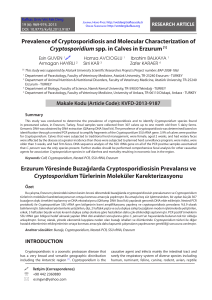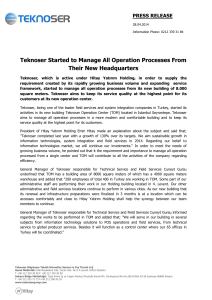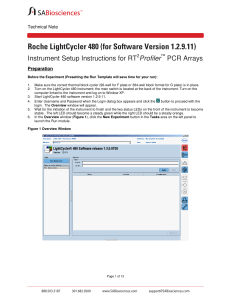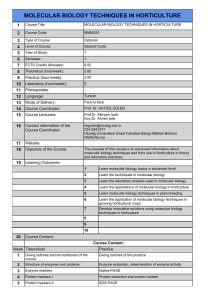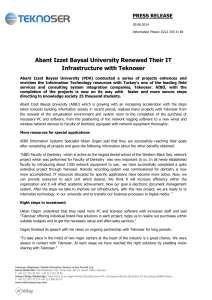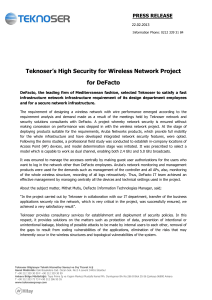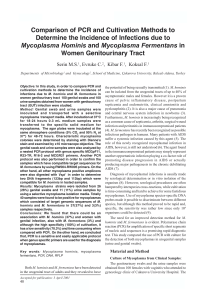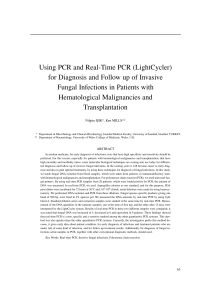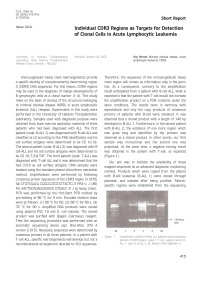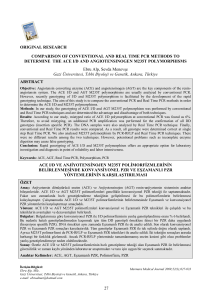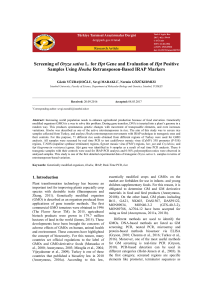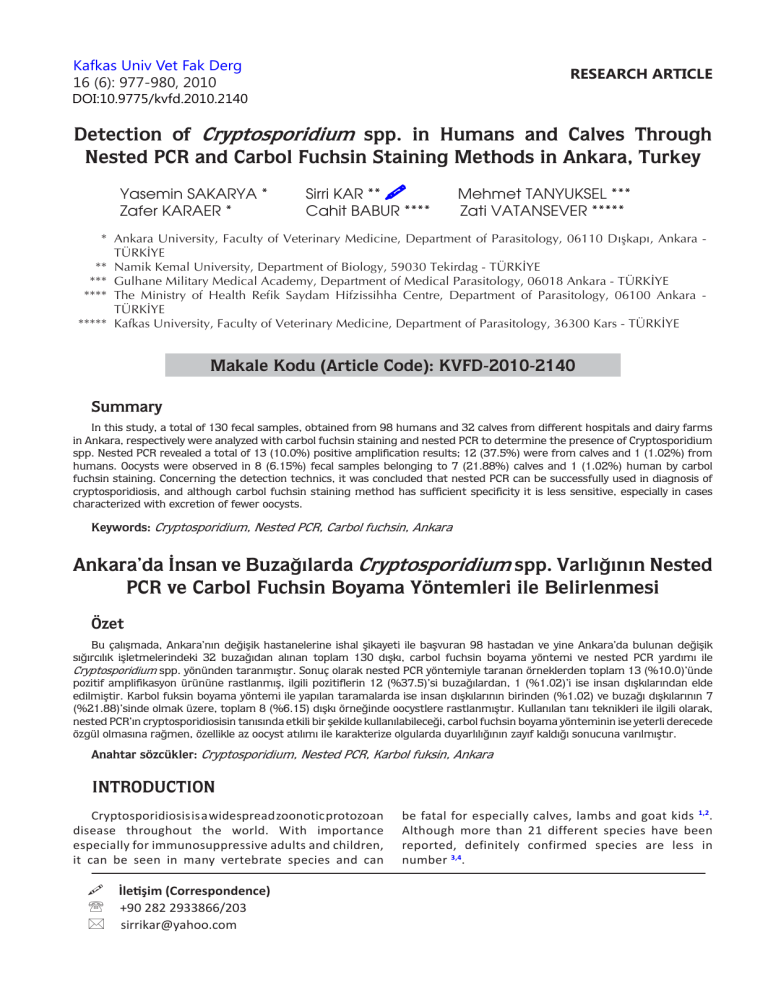
Kafkas Univ Vet Fak Derg
16 (6): 977-980, 2010
RESEARCH ARTICLE
DOI:10.9775/kvfd.2010.2140
Detection of Cryptosporidium spp. in Humans and Calves Through
Nested PCR and Carbol Fuchsin Staining Methods in Ankara, Turkey
Yasemin SAKARYA *
Zafer KARAER *
Sirri KAR **
Cahit BABUR ****
Mehmet TANYUKSEL ***
Zati VATANSEVER *****
* Ankara University, Faculty of Veterinary Medicine, Department of Parasitology, 06110 Dışkapı, Ankara TÜRKİYE
** Namik Kemal University, Department of Biology, 59030 Tekirdag - TÜRKİYE
*** Gulhane Military Medical Academy, Department of Medical Parasitology, 06018 Ankara - TÜRKİYE
**** The Ministry of Health Refik Saydam Hifzissihha Centre, Department of Parasitology, 06100 Ankara TÜRKİYE
***** Kafkas University, Faculty of Veterinary Medicine, Department of Parasitology, 36300 Kars - TÜRKİYE
Makale Kodu (Article Code): KVFD-2010-2140
Summary
In this study, a total of 130 fecal samples, obtained from 98 humans and 32 calves from different hospitals and dairy farms
in Ankara, respectively were analyzed with carbol fuchsin staining and nested PCR to determine the presence of Cryptosporidium
spp. Nested PCR revealed a total of 13 (10.0%) positive amplification results; 12 (37.5%) were from calves and 1 (1.02%) from
humans. Oocysts were observed in 8 (6.15%) fecal samples belonging to 7 (21.88%) calves and 1 (1.02%) human by carbol
fuchsin staining. Concerning the detection technics, it was concluded that nested PCR can be successfully used in diagnosis of
cryptosporidiosis, and although carbol fuchsin staining method has sufficient specificity it is less sensitive, especially in cases
characterized with excretion of fewer oocysts.
Keywords: Cryptosporidium, Nested PCR, Carbol fuchsin, Ankara
Ankara’da İnsan ve Buzağılarda Cryptosporidium spp. Varlığının Nested
PCR ve Carbol Fuchsin Boyama Yöntemleri ile Belirlenmesi
Özet
Bu çalışmada, Ankara’nın değişik hastanelerine ishal şikayeti ile başvuran 98 hastadan ve yine Ankara’da bulunan değişik
sığırcılık işletmelerindeki 32 buzağıdan alınan toplam 130 dışkı, carbol fuchsin boyama yöntemi ve nested PCR yardımı ile
Cryptosporidium spp. yönünden taranmıştır. Sonuç olarak nested PCR yöntemiyle taranan örneklerden toplam 13 (%10.0)’ünde
pozitif amplifikasyon ürününe rastlanmış, ilgili pozitiflerin 12 (%37.5)’si buzağılardan, 1 (%1.02)’i ise insan dışkılarından elde
edilmiştir. Karbol fuksin boyama yöntemi ile yapılan taramalarda ise insan dışkılarının birinden (%1.02) ve buzağı dışkılarının 7
(%21.88)’sinde olmak üzere, toplam 8 (%6.15) dışkı örneğinde oocystlere rastlanmıştır. Kullanılan tanı teknikleri ile ilgili olarak,
nested PCR’ın cryptosporidiosisin tanısında etkili bir şekilde kullanılabileceği, carbol fuchsin boyama yönteminin ise yeterli derecede
özgül olmasına rağmen, özellikle az oocyst atılımı ile karakterize olgularda duyarlılığının zayıf kaldığı sonucuna varılmıştır.
Anahtar sözcükler: Cryptosporidium, Nested PCR, Karbol fuksin, Ankara
INTRODUCTION
Cryptosporidiosis is a widespread zoonotic protozoan
disease throughout the world. With importance
especially for immunosuppressive adults and children,
it can be seen in many vertebrate species and can
İletişim (Correspondence)
+90 282 2933866/203
[email protected]
be fatal for especially calves, lambs and goat kids 1,2.
Although more than 21 different species have been
reported, definitely confirmed species are less in
number 3,4.
978
Detection of Cryptosporidium spp. in ...
The disease was firstly noted in humans in 1976
and today it is stated that the disease has an important
dimension in 90 countries from 6 continents 5. It is
also mentioned that cattle cryptosporidiosis is widespread throughout the world, and similar to human
cryptosporidiosis the incidence has rather differences
from regions to regions 6.
Cryptosporidium has biological monoxenous features.
The infection occurs mainly by taking oocysts through
water at foremost and food orally. These oocysts are
excreted through feces and they become infectious from
excretion onwards. Infectious oocysts are 4-6 μm in
dimension, round-elliptical in structure, containing 4 bare
sporozoites. Even taking fewer highly infectious oocysts
can cause the disease. Although the pathogen is placed
in the digestive system it leads to different types of
symptoms affecting the immune system, age and likely
infected tissues other than the intestine. The widespread
diagnostic evidence is diarrhoea characterized with the
ejection of plenty of oocysts 1,7. That is why diagnosis
is generally based on direct fecal examination. For this
purpose especially fecal staining methods such as acid
fast, carbol fuchsin and fluorescent staining can be
utilized 7. In epidemiological screenings and genetical
examinations PCR with its high sensitivity and specificity
is highly beneficial 8.
In this study, it is aimed to reveal to a certain extent
if Cryptosporidium spp. is widespread among people and
cattles in Ankara, and also to determine the efficiency
of nested PCR and carbol fuchsin staining methods in
such a screening.
MATERIAL and METHODS
Material
The study was carried with the fecal samples obtained
from 98 people who came to different hospitals with the
complaints of diarrhoea and from 32 calves with the
disease of diarrhoea in different dairy farms in Ankara.
Of these people, 38 patients were 1 year old and above;
the others were younger. 22 of the calves were 1-4
weeks old, and 10 of them were 1-6 months old. The
fecal samples from sick people and the calves were
brought to the laboratory within sterile containers and
kept at +4oC during the experimets.
Method
In order to reveal the presence of Cryptosporidium in
the feces, methods of carbol fuchsin staining and nested
PCR were employed. Before diagnosis, these feces
brought to the laboratory were washed with distilled
water by centrifugation in order to concentrate the
oocysts and to remove fecal-derived PCR inhibitors to
the utmost. For this purpose, 1 ml of each mixed sample
was taken and washed in centrifuge tubes of 10 ml with
the help of distilled water for 10 min at 2500 rpm, and
this was repeated until supernatant became clear. At
the last stage, 1 ml fecal suspension was attained by
adding distilled water onto the pellet, and the following
processes were carried out with this suspension.
Carbol Fuchsin Staining
The carbol fuchsin staining method used to display
oocyst existence in feces was performed according to the
methods described by Heine 9. Briefly, 50 μl of thoroughly
homogenized feces sample from the stock fecal suspension
of 1 ml was taken over a slide, and then carbol fuchsin (Merck)
of equal amount was added. After mixing, thin smear was
obtained by spreading. Shortly after air dried, this ready
smear mounted with a little drop of immersion oil was
examined for Cryptosporidium oocysts under a light
microscope at x40 magnification. Oocysts were counted at
20 fields, and average number of each field was calculated;
more than 20 oocysts were regarded as (++++), 6-20 oocysts
as (+++), 1-5 oocysts as (++) and less than 1 oocyst as (+).
Nested PCR
At this stage, 200 μl was taken from each homogenized
fecal samples and DNA extraction was performed by using
QIAamp DNA Stool mini kit. This DNA was preserved at
-20oC for PCR. Nested PCR technic was carried out by
applying protocol and primers described by Xiao et al.10.
The samples which were proved to be Cryptosporidium
positive in previous studies carried out in the Protozoology
Laboratory of the Faculty of Veterinary Medicine in
Ankara University were used as positive control.
At the first stage of PCR, the primers CryptoF
5’-TTCTAGAGCTAATACATGCG-3’ and CryptoR 5’CCCATTTCCTTCGAAACAGGA-3’ were used, which amplify
DNA fragment encoding SSU rRNA as 1.325 bp in length.
For each reaction, master mix was prepared as 25 μl
including 200 nM from each primer, 0.2 mM from each
dNTP, 0.025 U Taq DNA polymerase, 6 mM MgCl2, 1x PCR
buffer and the sample DNA of 1.5 μl, 1 μl of the reaction
products were later subjected to nested PCR method.
During Nested PCR, a base set of CryptoNF 5’GGAAGGGTTGTATTTATTAGATAAAG-3’ and CryptoNR 5’AAGGAGTAAGGAACAACCTCCA-3’ were used, which
amplify a region at about 826-864 bp in length in the
former product. The reaction was carried out at the
same way as the the previous process; however, the
quantity of the sample DNA was taken as 1 μl. Reaction
products of 15 μl were used for gel electrophoresis.
979
SAKARYA, KAR, TANYUKSEL,
KARAER, BABUR, VATANSEVER
The reactions were performed in a Biometra TGradient
(Whatmann Biometra) PCR thermocycler with a heater
lid. Both steps of PCR consisted of a total of 35 cycles
(45 sec at 94°C, 45 sec at 55°C and 1 min at 72°C). 5 min
of denaturation and 10 min extension period at 72°C
were performed.
RESULTS
In the research, 1 (2.5 years old) of 98 human feces
(1.02%) and 7 (1-4 weeks) of 32 calves feces (21.88%)
examined by carbol fuchsin staining method were found
positive in regards to Cryptosporidium spp. oocysts. In the
slides prepared from the positive samples the number of
oocysts at x40 magnification varied between 0.9-6.9 at
average for each field (Table 1).
Results of nested PCR of 130 fecal samples showed
a total of 13 (10.0%) positive amplifications; 12 (37.5%)
were from calves and 1 (1.02%) from humans. Of the
positive samples, 8 were also found as positive through
carbol fuchsin staining method. Eleven of the positive
results were obtained from the calves at the age group
of 1-4 weeks and one of them was from a 4.5 month
calf. The results of both nested-PCR and carbol fuchsin
staining method are given in Table 1.
Table 1. Positive results of carbol fuchsin staining and nested
PCR methods
Tablo 1. Carbol fuchsin ve nested PCR yöntemlerine ait pozitif
sonuçlar
Source
Calf 1
Calf 2
Calf 3
Calf 4
Calf 5
Calf 6
Calf 7
Human 1
Calf 8
Calf 9
Calf 10
Calf 11
Calf 12
Carbol Fuchsin Staining
The Average Number of
Evaluation
Oocysts in Each Field (x40)
0.9
1.9
2.7
3.2
4.9
5
6.9
4.9
-
0.9
1.9
2.7
3.2
4.9
5
6.9
4.9
+
++
++
++
++
++
+++
++
-
NestedPCR
+
+
+
+
+
+
+
+
+
+
+
+
+
DISCUSSION
It is notified that the prevalence of cryptosporidiosis
in Turkey, which is regarded as widespread throughout
the world 1,7, varies between 0-35.5% in people 11-15
and 7-63.3% on calves 16,17. However, our molecular
research reveals that the disease shows a prevalence
of 37.5% (12/32) in calves with diarrhoea and 1.02%
(1/98) in people with a complaint of diarrhoea in Ankara
province.
Cryptosporidiosis is reported to be the scourge of
especially young people and the adults who are immune
deficient 1,7. In this study, 38 of 98 human feces were
from one year old and above; 60 were from younger
people and the only positive result belonged to a 2.5
year old boy. As for the calves, 22 of them were 1-4
weeks and 10 were 1-6 months. While 11 of 12 positive
results, examined by PCR, were from 1-4 week calves,
only one positive result was obtained from 4.5 month
calf. Less number of positive results among people
renders it difficult to interpret. However, our results
reveal that the disease is more widespread in the calves
examined, especially a few months old. In fact, studies
on the cattle cryptosporidiosis indicate that the disease
is especially more widespread among the young cattles,
being noteworthy in calves 4 days and 4 weeks old 18.
The symptom of the disease is characterized by
homogeneous, yellowish and aqueous diarhoea, but
these signs are not sufficent alone for a definite clinical
diagnosis 7. In this study, although every patient examined
had complaints of diarrhoea, only 13 (10.0%) of them
were found positive by nested PCR. But, this number
was less with carbol fuchsin staining method (8 positive,
6.15%). Nonetheless, the signs of diarrhoea in the
patients who were carbol fuchsin positive were closer
to characteristics of diarrhoea abovementioned. But as
for the patients who were negative by staining method,
colour, density and appearance of diarrhoea was more
different. On the other hand, the feces of 4.5 month calf
detected as positive with the staining method was also
aqueous, but had an appearance closer to normal colour
and contained normal feces particles.
In order to diagnose cryptosporidiosis, many different
Fig 1. Nested PCR scanning results of positive fecal
samples. M: 100 bp DNA size marker (Invitrogen).
1: Positive control, 2-14: Positive samples, 15:
Negative control
Şekil 1. Pozitif dışkı örneklerinde nested PCR
sonuçları. M: 100 bp DNA marker (Invitrogen). 1: Pozitif
kontrol, 2-14: Pozitif örnekler, 15: Negatif kontrol
980
Detection of Cryptosporidium spp. in ...
methods can be applied. Of those, staining, PCR, IFAT
ve ELISA applied to feces are the foremost diagnostic
technics. While staining methods such as acid fast,
carbol fuchsin and fluorescent staining are accepted
to be effective in diagnosis 1,7, and even if they are
frequently applied, their sensivities and specifities are
known to be low 19.
Carbol fuchsin staining technic is evaluated by
laboratories to be advantageous due to its simplicity and
practical importance. With this technic, the oocysts can
be defined by the specialists easily. However, it has some
restrictions in that as the other staining methods, the
number of oocysts in the slides prepared from the same
feces can vary. In addition, the structure of oocysts can
be degenerated when the slides are kept longer, and
the number of oocysts should be 10.000-500.000 per
gram of feces in order to have positive results from microscopic examination 5,7,20,21. Our results confirmed that
carbol fuchsin staining method can be used for diagnosis
of clinical cases. In diagnosis of subclinical cases, PCR
was reported to be more sensitive than conventional
staining methods and other diagnostic technics 10.
Furthermore, nested PCR is 4-5 times more sensitive
than classical PCR 22, and can detecteasily the carriers
showing no clinical symptoms. On the other hand, gene
regions chosen as a target for PCR are also one of the
important effects on the sensitivity and specifity of these
molecular technics. As pointed out by some researchers
previously 23,24, the primers targeted SSU rDNA coding
region yielded desired amount of DNA in this study.
REFERENCES
1. Dubey JP, Speer CA, Fayer R: Cryptosporidiosis of Man
and Animals. CRC Press, USA. pp. 199, 1990.
2. Miller DL, Ligett A, Radi ZA, Branch LO: Gastrointestinal
cryptosporidiosis in a puppy. Vet Parasitol, 115, 199-204,
2003.
3. Egyed Z, Sreter T, Szell Z, Varga I: Charecterization of
Cryptosporidium spp.- Recent developments and future needs.
Vet Parasitol, 111, 103-114, 2003.
4. Xiao L, Sulaiman IM, Ryan UM, Zhou L, Atwill ER, Tischler
ML, Zhang X, Fayer R, Lal AA: Host adaptation and hostparasite co-evolution in Cryptosporidium: Implications for
taxonomy and public health. Int J Parasitol, 32, 1773-1785,
2002.
5. Fayer R, Morgan U, Upton SJ: Epidemiology of
Cryptosporidium: transmission, detection and identification.
Int J Parasitol, 30, 1305-1322, 2000.
6. Starling CR, Arrowood MJ: Cryptosporidia. In, Kreier JR,
Baker J (Eds): Parasitic Protozoa, 2d ed. vol. 6. Academic Press.
San Diego, pp.156-225, 1993.
7. Sears CL, Kirckpatrick BD: Cryptosporidiosis and isosporiosis. In, Gillespie SH, Pearson RD (Eds): Principles and
Practice of Clinical Parasitology. pp. 139-164, John Wiley &
Sons Ltd. Press. 2001.
8. Carey CM, Lee H, Trevors JT: Biology, persistence and
detection of Cryptosporidium parvum and Cryptosporidium
hominis oocyst. Water Res, 38, 818-862, 2004.
9. Heine J: Eine einfache Nachweismethode für Kryptosporidien
im Kot. Zbl Vet Med B, 29, 324-327, 1982.
10. Xiao L, Singh A, Limor J, Graczyk TK, Gradus S, Lal AA:
Molecular characterization of Cryptosporidium oocysts in
samples of raw surface water and wastewater. Appl Environ
Microbiol, 67, 1097-1101, 2001.
11. Yücel A, Bulut V, Yılmaz M: Elazığ yöresinde diyareli
olgularda ve hemodiyaliz olgularında Cryptosporidium spp.
araştırılması. Türk Parazitol Derg, 24 (2): 126-132, 2000.
12. Al-Qubaji
M:
Diyareli
çocuk
dışkı
örneklerinde
Cryptosporidium oocyst’lerinin araştırılması. Doktora Tezi.
Ankara Üniv. Sağlık Bili Enst, Eczacılık Programı, Ankara,
2005.
13. Doğan N, Akgün Y: İshalli olgularda Cryptosporidium
oocystlerinin araştırılması. Türk Parazitol Der, 22 (3): 243-246,
1998.
14. Özcan K, Köksal F, Aksaray N, Yiğit S: Çocuk ishallerinde
Cryptosporidium’un rolü. T Klin Tıp Bil Araş Derg, 5, 329-332,
1987.
15. Ok ÜZ, Kavaklı K, Çetingül N, Öztop S, İşli G, Üner A,
Özcel MA: Kemoterapi uygulanan tümörlü çocuklarda barsak
parazitlerinin sıklığı. Türk Parazitol Derg, 19, 385-390, 1995.
16. Başoğlu A, Turgut K, Maden M, Kaya O: İshalli buzağılarda
Cryptosporidium’ların
önemi
üzerinde
araştırmalar.
Hayvancılık Araş Derg, 2 (1): 40-41, 1992.
17. Emre Z, Aalabay M, Düzgün A, Çerçi H: Comparison
of staining and concantration techniques for detection of
Cryptosporidium oocysts in cattle faecal specimens. Turk J Vet
Anim Sci, 21, 293-296, 1997.
18. Yu JR, Seo M: Infection status of pigs with Cryptosporidium
parvum. Korean J Parasitol, 42 (1): 45-47, 2004.
19. Clark DP: New insights into human cryptosporidiosis. Clin
Microbiol Rev, 12 (4): 554-563, 1999.
20. Weber R, Bryan RT, Juranek DD: Improved stool
concentration procedure for detection of Cryptosporidium
oocysts in fecal specimens. J Clin Microbiol, 30 (11): 28692873, 1992.
21. Kar S, Najdrowski M, Daugschies A: Cryptosporidium
parvum ile enfekte edilen bir buzağıda ookist atılımının carbol
fuchsin, modifiye ziehl neelsen boyama teknikleri ve klasik
PCR ile takibi. 15. Ulusal Parazitoloji Kongresi, Poster Sunumu,
18-23 Kasım 2007.
22. Kato S, Lindergard G, Mohammed HO: Utility of the
Cryptosporidium oocyst wall protein (COWP) gene in a nested
PCR approach for detection infection in cattle. Vet Parasitol,
2475, 1-7, 2002.
23. Xiao L, Escalante L, Yang C, Sulaiman I, Escalante
AA, Montali RJ, Fayer R, Lal AA: Phylogenetic analysis of
Cryptosporidium parasites based on the small-subunit rRNA
gene locus. Appl Environ Microbiol, 65, 1578-1583, 1999.
24. Xiao L, Morgan UM, Limor J, Escalanye A, Arrowood M,
Shulaw W, Thompson RCA, Fayer R, Lal AA: Genetic diversity
within Cryptosporidium parvum and related Cryptosporidium
species. Appl Environ Microbiol, 65, 3386-3391, 1999.

